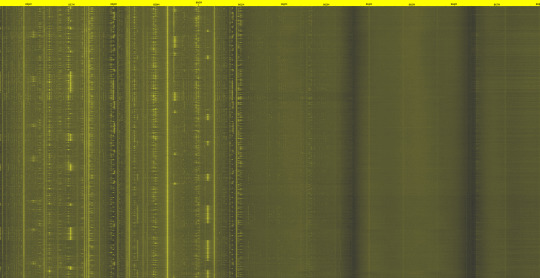#software define
Photo




[ultrakill]
war & peace (i)
#ultrakill#v1#v2#blood cw#injury cw#dismemberment cw#doodle tag#they may not talk but. i had a lot to say. so.#two machines defined by roles long since past#i think v2 takes pride in an identity that never was#and v1 has iterated so much on its function that it's become something else#to the point where v2 isn't prepared for their first encounter#v1 acts bizarrely. it isn't what it's supposed to be.#whereas v2 clings to its parameters because...what else is there anymore#its software is struggling too#but it fights to keep in line with its purpose#v1's control over that is long gone#it's lost in endless permutations of an ai's understanding of war#spun off somewhere into space...and it's got mixed feelings about it#GOD there is way too much to put into tags!!#but will i make a post about it NO...bc im shy
789 notes
·
View notes
Text
My most male trait is the "ye I can do that" attitude abt stuff I have no means of actually knowing whether I can do
#the overconfident megalomania is very hench ya know#my ''''male'''' gender ID is defined like 90% through the attitude and 10% through the physically male-aligned dysphoria#trans#nonbinary#transmasc#'ye I can make a fully functionning custom vtuber in like a month sometime *to learn unreal* (me who barely knows how to navigate#3D software and hasn't rendered or 3D animated anything in years let alone rigged anything ever).#if doig and india can make a custom vtuber set-up in a games engine why shouldn't I be able to do it? I too am a trained 2D animator!#(they've only been working on theirs for god knows how long and there's two of them)'#LOOK I know enough games & 3D ppl to ask any questions I might have#I *have* doigswift's content as a reference re vtube specific workflows that might be useful that I can look up#I know it's possible to do#I know it's learnable skills#I learnt blender in 2 weeks for my so-far-limited purposes a few years ago#it'd be a limited amount of modelling and rigging to do which will be a great project to learn that stuff through#and making it a vtuber that can be run through unreal will work great to add to my virtual production & mocap training#and I'll get a cute vtuber out of it#I THINK IT'S DOABLE#oh oh! also I've learnt C++ before which unreal runs on and I am learning more coding as we speak anyway so that might come in handy too!
11 notes
·
View notes
Note
i have some questions and i hope you don't take offense, i'm just genuinely curious. is it scary having prosopagnosia, like not being able to recognize your family? do you just see their faces as complete strangers? also are you able to recognize celebrities for who they are or do you rely on something (like tags on tumblr or their voices in shows, etc) to be able to put names to faces? i remember with color rush, the kid could only remember his best friend by his hairstyle and then when his friend got a haircut, he wasn't able to recognize him. is that something you experience, too?
Hi, anon, I don't mind at all! Thank you for your questions. 💜 I'll try and answer them all but my experience with prosopagnosia might not be universal. It's more of a spectrum with some people simply having trouble remembering faces to cases even more severe than what I'm experiencing. If you're curious, the late (and absolutely wonderful) Oliver Sacks talks about it in this short video. He was a neurologist and psychiatrist and also had prosopagnosia.
That being said, I don't think prosopagnosia is scary at all. I've always had it (though there is a version of it that is acquired later in life through trauma and brain damage - that must be incredibly scary) and it's a part of me. Tbh I just always assumed everyone was like me and I was just especially bad at socialising - like there was some secret people refused to share with me. Much later I was in therapy for something unrelated and it came up. Luckily my therapist was a neurologist so she diagnosed me.
It's more... isolating and a bit embarassing. It wasn't so bad when I was younger because you pretty much stick with the same crowd in and outside of school anyway, so you learn how to tell them apart by their clothes and voices and where they sit, what number their sports jersey is etc. It's only ever really bad when unexpected things happen - like someone changing their hair or completely changing the way they look. Or when I meet people where I don't expect them to. I then no longer recognise them and that can lead to some awkwardness (like in the scene you described from Color Rush).
I remember that I once talked to a person who I thought was my dad for a whole few minutes until my actual dad showed up. I about died when I realised (so did the other person lmao).
It only ever became isolating when I went to uni and met lots of new people. I mostly met everyone once, got along just fine and then the next week (or out and about on campus) I no longer recognised them. I didn't make a lot of friends at uni. 🤣
But no, I don't think of family and friends as strangers just because I don't see their faces. Faces aren't really a part of my thought process. You'd probably have trouble telling apart your loved ones by their ankles or wrists but you wouldn't consider them a stranger because of it. Does that make sense?
As for favourite celebrities, it's a mix of voices and features that stand out. Pictures are really bad because then they're not moving and talking and that's such a huge part of what makes someone uniquely beautiful. I often have to ask @cytharat to help me out (and she's wonderfully patient and understanding). Maybe that's why I like making gifs so much?
Also, I like interesting faces and facial features that stand out: noses, moles, scars, asymmetry - things that aren't considered classically beautiful are incredibly beautiful to me because I can actually "see" them.
If all else fails I just compare ears because ears are actually a lot like like fingerprints. 🤣
#prosopagnosia#ask#about me#thank you for your questions#it's so interesting to talk about because we define ourselves so much by what we see and understand#so it never occurred to me that prosopagnosia could be scary#or that not seeing faces would automatically turn people into strangers#but it must be really scary for a non-faceblind person to think about#the best analogy i ever came across for prosopagnosia was#you know how computers have software for certain tasks?#well people have special software for recognising faces#i don't have that software#so for me trying to tell apart faces is like trying to tell apart individual blades of grass lmao
15 notes
·
View notes
Text
Go is a bad programming language
I need to take a minute to rant about the go language and a few of the many, many things wrong with it.
1. Unused variables are compile-time errors.
So if you're debugging this:
x, y := foo()
doSomething(x)
doSomething(y)
and you decide to comment out doSomething(x) in order to check something, then hey, your code doesn't compile anymore! No, if you want to comment out a few lines while debugging, you also have to go up and make sure you also remove any declarations or assignments to variables that are only used in that block.
This is absolutely infuriating, and is one of the least developer-friendly features I've ever seen (excluding languages that were explicitly designed to be terrible).
So why did they do it? Why would the designers make such a ridiculous decision? The answer is simple:
2. Go doesn't consistently distinguish assignment from declaration.
Some languages distinguish between declaring a variable (e.g. int x) and setting it (e.g. x = 12); others don't bother and just let x = 12 be declaration if needed. There are pros and cons to both, but Go manages the difficult task of achieving the worst of both worlds.
You can declare var x int and assign x = 12, but you can also combine the two with x := 12 - the := implicitly declares the variable being assigned.
Fortunately, go IS smart enough to not let you double-declare something - var x int; x := 12 is a syntax error.
But go also lets you assign multiple values. What do you think this does?
var x int = 1
x, y := 2, 3
fmt.Println(y)
fmt.Println(x)
Did you guess that this is a syntax error? Wrong! It prints 3, then 2 - the := operator is fine with the fact that x already exists, as long as at least one of the variables you're assigning to does in fact need to be declared.
What about this:
var x int = 1
if true {
x, y := 2, 3
fmt.Println(y)
}
fmt.Println(x)
If you "the same thing", you're wrong! This one IS a syntax error! Why? Because now that it's in a separate block, that := is now declaring x instead of assigning to it! And the new x is unused, so the compiler can't let you do that! Note, though, that if the first print printed both x and y, the compiler would not have caught that for us. The code would just compile fine and be wrong. That is the golang experience.
So why would a language allow a := that changes meaning but only when there are multiple variables? Simple! It's because:
3. Go has no error handling whatsoever
No exceptions, no maybe monads, no anything. Just a convention that functions that might fail should return a pair of (result, error).
This means code that in a sensible language might look like
print(foo(bar(3), baz("hello")))
in go instead looks like
a, err := bar(3)
if err != nil {
return err
}
b, err := baz("hello")
if err != nil {
return err
}
c, err := foo(a, b)
if err != nil {
return err
}
fmt.Println(c)
Yay boilerplate!
So obviously you need := to allow some things to already exist, otherwise you'd have to give all those errs different names, and who has time to come up with that many variable names?
4. Don't use go.
Anyway, these are just three of the many, many things I hate about go, which also include
Switch statements for values vs for types have almost-but-not-quite identical syntax (they should either be the same or be different, preferably different).
Type switch naming is stupid (sensible languages let you name the variable in each case instead of just renaming the variable once at the beginning).
Unused imports are a compile-time error (so incredibly stupid and frustrating).
Capitalization distinguishes public values from private ones (result: APIs cannot use capitalization in a meaningful way, because by definition every member of the API must be capitalized).
Extremely limited type system (terrible type inference, no generic methods on objects, no co- or contravariance among functions or objects - a function that returns a Square is not a function that returns a Shape and cannot be used as one).
Any public type can be instantiated with a "zero value", so every object method must do something sensible if the object is completely uninitialized (I saw some code in one of go's own built-in libraries that represented "any nonnegative integer or undefined" as a pair of (val int, isZero bool); a value of 0 is undefined unless isZero is true, in which case it means 0. I don't think that would pass code review in any other language at all).
Surprisingly awkward and unintuitive concurrency support for a language that claims to have been built with concurrency in mind.
Weird and inconsistent special magical cases (e.g. if g() returns three arguments and f() takes three arguments, then f(g()) is fine; if g returns two, you can't f(1, g()) or anything like that).
More things that I won't spend any more time writing up, I just needed to get this out of my system.
#it's not often that I use a statically typed language#find errors#and think to myself 'python's type system would've caught that'#also side note I don't think the reason unused variables are a syntax error is actually because they thought about the case I described#I think they just thought 'well production code probably shouldn't define variables it doesn't use so we'll make that a hard requirement'#go was clearly developed by people who don't have a lot of respect for the language's users#Rob Pike (one of the inventors of go) described the target audience of the language with:#'They’re not capable of understanding a brilliant language but we want to use them to build good software'#unfortunately they failed at that too#I have yet to see anything written in go that I would actually consider 'good software'#it's always bloated and full of boilerplate and hard to follow and frequently concurrent when it doesn't need to be#rants#ok I feel better now that I've ranted about this
143 notes
·
View notes
Text
god I fucking hate corporate buzzword bullshit
#“oh this new software tool will help foster a sense of ~belonging~#shut up shut up shut UP#that doesnt mean anything thats just words!!!#how the FUCK is a new system to enter data into gonna help make me feel like i BELONG#“we're all about fostering a community of belonging and welcome”#SHUT. UP.#let me do my job and go i dont want these fuzzy meaningless words gdamn#and stop making me go to workshops and conferences that are JUST ABOUT these good sounding words#give me a tangible plan. steps. actions to take. a definable goal.#gonna start chewing through my computer keyboard#how much money has this company spent hiring consultants and arranging conferences just to come up with the tagline ~belonging 😇~#im not cut out for this man#WHAT. DOES. IT. MEAN.
3 notes
·
View notes
Text


Last weekend I was in another town for a birthday and I couldn't pass up the chance to capture the sub-ghz spectrum for a future project. The first image is a 9.5 hour capture of portion of the spectrum from a city of nearly a million people. The second image is 1.5 hours in same band from my home in a town with a population of 6,000.
4 notes
·
View notes
Text
Who loves Canadian mediumwave / AM talkradio? KiwiSDR makes it easy to stream favorite stations if you're tired of chasing the urls for your internet radio. Here is a list which tracks working radio servers you can use to tune in Canadian mediumwave (CBC Radio and also some indie broadcasters).

2 notes
·
View notes
Text
baffling that on a forum where someone asks for expertise and help on a highly specific technical topic and responders say "i dont know what that is but i googled for 5min and i think its bad"
???? IF YOU DO NOT KNOW WHY ARE ANSWERING????
#This is why architects can't be taken seriously#The topic in question is parametric architecture and some genius high intelligence architects responded Don't Know What That Is. Seems Fake#Parametric architecture is just architecture but with a computer and using coding systems to make things better#You can learn by practising#Architecture#like you use software and define a steel beam and say I am adding an INPUT so i can freely choose how long the beam should be#and it can be more complicated than that but idea is that you set up a 3d design which you can adjust by changing input values
1 note
·
View note
Text
#seo services#web development#social media marketing#consulting#website maintenance#ecommerce#Cloud Solutions#Networking Solutions#Software Define Networking#Data Centre#Virtualization Services#Internet of Things#Security Solutions#IT managed services#Network Architecture Design & Implementation#IT Facilities Managed Services#Annual Maintenance Contract#Relocation Migration Plan & Implementation
3 notes
·
View notes
Text

Listen to a binaural recording made with two websdrs featuring lively political debate among ham radio operators in New England. They talk about how they don't like democracy and just want a white supremacist ethnostate instead. Then they get jammed by other stations who play music and sound effects.
The 75 meter ham radio band is 4chan for boomers.
#ham radio#amateur radio#shortwave radio#websdr recording#software defined radio recording#fascist hams
2 notes
·
View notes
Text
famous defining video app of gen z. youtube
#definitely the generation thats the famous defining cultural platform of yup that one for sure boss#its owned by our software licenser so we can put it in the ad copy and everything
3 notes
·
View notes
Text
Capture Aero Data via RTL-SDR

A British Airways 747 goes by - not too fast, partial flaps extended. You can intercept its voice and data radio signals with a properly set up RTL-SDR! Voice on the VHF-Airband is an easy catch. So is ACARS data, whether in the old signal format or the new VDL Mode 2. Know what is going on. See the book "Airband Radio on the RTL-SDR" for tips, tricks, do's and dont's for using software defined radio to harvest aero signals en masse.
2 notes
·
View notes
Text

Very nice reception this afternoon, listening on 30 meters with noise reduction on the low setting. Every WebSDR should incorporate such nice client-side filtering.
1 note
·
View note
Text
Optimizing Operations with Network Automation: Best Practices and Solutions

Network Automation is a game-changer in the realm of IT operations, offering a plethora of benefits for optimizing network management tasks. To harness its full potential, organizations must adopt best practices and implement effective solutions. In this blog post, we will explore some key best practices and solutions for optimizing operations with Network Automation.
Automating Routine Tasks
The cornerstone of Network Automation lies in automating routine tasks such as configuration changes, device provisioning, and network monitoring.
By automating these repetitive tasks, organizations can streamline operations, reduce manual errors, and improve overall efficiency.
Utilizing Orchestration Tools
Orchestration tools play a crucial role in managing and coordinating automated processes within the network.
Network Automation tools provide a centralized platform for designing, executing, and monitoring automation workflows, ensuring seamless integration and efficient operation.
Implementing Self-Healing Mechanisms
Self-healing mechanisms leverage Network Automation to detect and remediate network issues automatically.
By implementing proactive monitoring and alerting systems coupled with automated remediation scripts, organizations can minimize downtime and improve network reliability.
Integrating with Monitoring and Analytics
Integrating Network Automation with monitoring and analytics tools enhances visibility and insight into network performance.
By collecting and analyzing real-time data, organizations can identify trends, predict potential issues, and proactively optimize network resources.
Standardizing Configuration Management
Standardizing configuration management practices is essential for maintaining consistency and compliance across the network infrastructure.
Network Automation enables organizations to enforce standardized configurations, ensure adherence to security policies, and streamline auditing and compliance processes.
Implementing Change Management Processes
Implementing robust change management processes is critical for managing network changes effectively.
Network Automation can facilitate change management by automating change requests, approvals, and deployment processes, ensuring minimal disruption and maximum efficiency.
Get More Insights On This Topic: Network Automation
#Network Automation#IT Automation#DevOps#Network Management#Automation Tools#Software Defined Networking#Infrastructure Automation#Cloud Computing
0 notes
Text
Making Transformation Towards Software-Defined Vehicles a Reality: Automobil Electronik Cover Story
KPIT drives automotive transformation towards software-defined vehicles, expanding ambitiously in Europe to tackle mobility challenges.
#co-founder of KPIT Mr Kishor Patil#Gabriel Seiberth Making Transformation Towards Software-Defined Vehicles#challenges of the automotive and mobility industry software-defined vehicle#turnover of KPIT globally#software in cars#vehicle architecture#software integration#electric vehicle (EV) programs#car domains and general middleware architecture#automotive security
0 notes
Text
Unlocking Financial Freedom with DeFinance

In a world where financial security is paramount, having the right partner to navigate the complexities of personal and business finance is crucial. At DeFinance, we're dedicated to empowering individuals and businesses alike to achieve their financial goals and secure a brighter future.
Our Commitment to You
Personalized Financial Solutions: We understand that every individual and business has unique financial needs and aspirations. That's why we offer personalized financial solutions tailored to your specific goals and circumstances.
Expert Financial Guidance: With a team of seasoned financial experts, we provide expert guidance and advice to help you make informed financial decisions. Whether you're planning for retirement, managing investments, or starting a business, we're here to support you every step of the way.
Comprehensive Services: From financial planning and wealth management to tax consulting and business advisory, we offer a wide range of services to address all aspects of your financial life. Whatever your financial needs may be, we have the expertise and resources to help you succeed.
Exceptional Customer Service: At DeFinance, client satisfaction is our top priority. We strive to provide exceptional customer service and support, ensuring that you receive the attention and care you deserve throughout our partnership.
Experience Financial Excellence with DeFinance
Ready to take control of your financial future? Experience the difference with DeFinance. Contact us today to learn more about our services and how we can help you achieve financial freedom and success.
0 notes